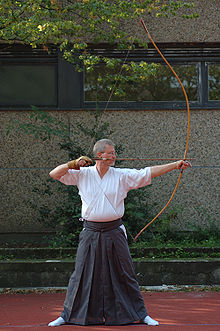|
Obi (martial arts)
 Many Japanese martial arts feature an obi (Japanese: 帯) as part of their exercise outfit. Such an obi is often made of thick cotton and is about 5 cm (2 in) wide. The martial arts obi are most often worn in the koma-musubi knot (square knot); in practice where a hakama is worn, the obi is tied in other ways. In many martial arts, the colour of the obi signifies the wearer's skill level. Such colours usually start from white for beginners and end in black or red-and-white for masters. DescriptionThe colour of the obi signifies the wearer's skill level in certain martial arts. Such colours typically start from white for beginners and progress through yellow, orange and red (in varying order), green, blue, brown, and culminating in black for masters. In some cases stripes are added to distinguish additional levels, or the rank of a master beyond the 1st dan. The red obi has the greatest variation among martial arts rankings. In some martial arts it is used for the highest dan ranks, the founder of a style or a grandmaster, while in others it designates a low or unranked beginner. The obi is most often tied with the koma-musubi knot, which resembles the reef knot (see diagrams). Unrestricted use In several martial arts, an obi is worn but with a single colour across all competition classes or with a colour which carries no significance. In some of these cases, a hakama is worn which covers the obi.
AikidoUnlike in many other martial arts, an adult practitioner of aikido does not traditionally wear a coloured obi,[3] though in some schools different colour codes have been formed,[3] especially for children. A child's obi ranges from white for beginner level to 7th kyū, other colours for the rest of the kyū levels, and black for levels 1st dan and up.[4] In some aikido schools, wearing a hakama is a privilege earned by reaching the first dan level. In other schools, all practitioners may wear a hakama. Once using a hakama, the colour of obi does not matter since it will be covered by the hakama.[4] Below is a typical example of obi colours by level in aikido:[3]
However, aikido schools worldwide may use their own systems with little reference to other schools save the use of a black belt for at least some dan grades. Bujinkan Budō TaijutsuThe Bujinkan (武神館) makes use of only a limited set of belt colours, however there are also different associated uniform emblems or wappen (ワッペン), the style of which varies dependent on the grade of the Budoka. Unlike many other martial arts, the number of Dan grades extends to Jūgodan (15th Dan), and practitioners at this grade of may also be gifted the status of Dai Shihan (大師範, roughly translated as "senior instructor") by the Sōke.[5][better source needed] This title also comes with its own wappen style featuring a purple background.
JudoBelow are the colours of obi worn for judo practise. Junior practitioners have a different colour range.[6] There are also other colour ranges used worldwide.
Ju-jitsuThe following table lists standard colours for obi used for ju-jitsu practise,[7] and alternative colours that may be used by different ju-jitsu federations.[citation needed]
KarateThe following table shows karate ranks and the respective obi colours worn by adults in the major styles: Kyokushin, wadō-ryū, Shotokan KUGB, and Shitō-ryū.
For Kyokushin style, stripes on non-black obis can be either black or the next level's colour. Some brown obi sport white stripes. On a black obi, gold is the most common stripe colour, though some higher degree blackbelts prefer to wear a plain stripeless black obi. Note that some dojos in Kyokushin use a more elaborate striping system for children, allowing for a higher frequency of exams. For Shokotan and Shitō-ryū styles, stripes are white. Shitō-ryū additionally has a 10th–15th dan, wearing a dark blue obi.[citation needed] Ninjutsu
Ninja obi are required within JNF and WNF.
See alsoFootnotesNotesCitations
Sources
|
||||||||||||||||||||||||||||||||||||||||||||||||||||||||||||||||||||||||||||||||||||||||||||||||||||||||||||||||||||||||||||||||||||||||||||||||||||||||||||||||||||||||||||||||||||||||
Portal di Ensiklopedia Dunia

